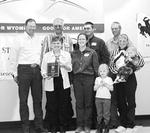|
Sublette Examiner Volume 3, Number 13 - June 26, 2003 brought to you online by Pinedale Online by Cat Urbigkit About 130 people drove from all corners of the state Wednesday to converge on Pinedale to celebrate a family's history of environmental stewardship. The Wyoming Stock Growers Association tapped the Joel and Susan Bousman family as the 2003 Environmental Stewards for their East Fork Livestock operation in the Boulder area of southern Sublette County. Joel Bousman is a leader in the agricultural industry, serving on various boards, testifying before our nation's Congress when needed and taking the initiative to help create a voluntary permittee-monitoring program for the Silver Creek Common Allotment. The voluntary permittee monitoring on Forest Service allotments helps the permittees identify and solve ecological concerns on the allotments, document their stewardship for their official allotment file, and allows the use of sound science to benefit the range, according to Sublette County Extension Agent Eric Peterson. Results of the monitoring effort have been significant, according to Joel Bousman. Cattle distribution has improved, the cattle have increased in performance (including health, weight and condition), and the association has been granted an extension of two weeks on the cattle grazing season on their national forest allotment, which rings in with about a $5,000 savings to the permittees. "We have been able to document our stewardship," Bousman said, in addition to building trust and communication among all parties, as well as public and agency education and permittee education. Wednesday's celebration included a half-day of presentations about the family and its ranch operation, and then participants loaded into buses to tour the ranch before returning to Pinedale for a fabulous meal and awards presentation. The Bousman family history goes back six generations in Sublette County, beginning with Knute Jomen's settlement of the East Fork River country in the late 1880s. The family began its cattle outfit then, and it's a thriving business enterprise today. East Fork Livestock is a Hereford-based cattle outfit, running both cows and calves and yearlings. Heifers begin calving in late March on private ranch lands, followed by the mother cows in mid-April. Joel and Susan Bousman's son Jim described the cycle encountered throughout the year in the cattle ranching operation. After calving, community brandings occur in May, with the assistance of neighbors being an important component in the operation. The cattle head to desert allotments administered by the Bureau of Land Management in first week in May, for a 45-day grazing season, then move onto mountain allotments on the Bridger-Teton National Forest. This gives the hay meadows on the private ranchlands along the East Fork River a seasonal rest from grazing pressure. "They (the cattle) need to stay off it all summer so we can grow some hay," Jim said, adding that the key factor in making that happen is good management on the national forest allotment. "The key to good management is through good distribution," Bousman said, noting that spreading the cattle out on the allotment allows these grazers to utilize the resource in an efficient manner. Three or four range riders are hired to move the cattle and keep them spread out in this 38,000-acre allotment of rough mountain country, most of which falls within designated wilderness area. Home ranches must produce hay in order to get the cattle through those snowy Sublette County winters. This forage production is entirely dependent upon irrigation water. "If we don't have irrigation water, we're in trouble," Bousman said, adding that water is the lifeblood of the operation. Flood irrigation via a diversion from the East Fork River allows the ranch meadows to be irrigated from about June 10 to July 10, when the river level drops too low to divert an adequate amount of water. "We don't have any storage on the East Fork River," Bousman explained. The use of flood irrigation (rather than sprinklers or pipe systems) is an efficient system for the ranch ecosystem, Bousman said. Early flows provide for raising the water table, ensuring moisture for later in the season. "If you can't get the sub up, you can't grow any hay," Bousman said. This serves as a type of underground water storage, bringing the water table to the surface, which then serves to recharge the river throughout the year, providing for the maintenance of the fishery. Haying begins July 20 and generally lasts through to end of August. It's a family undertaking, with even the kids getting involved, as well as an Amish family that arrives from Pennsylvania to help in the harvest. When the temperatures in the high country begin to get a little nippy and storm clouds hover, the cows begin their drift south to home ranges, generally in mid-September. The Bousman cattle are mixed with those belonging to other cattle outfits in the association, so they must be sorted and herded to their home meadows. Once again the neighbors are an important factor in getting the job done. Fall grazing occurs on the ranch's private pastures with some state leases being used as well. Yearlings are shipped in the fall, and busy days are spent preg-testing, weaning, vaccinating and culling. Things settle down as winter begins, with daily feeding of hay beginning in December, but sometimes as early as Thanksgiving. The cattle are put on full feed from the back of a wagon through calving, when the cycle begins anew. Joel Bousman said he knows of no stronger incentive to take care of the land than to know that your family's future depends on it: "God bless Wyoming and keep it wild." Photo credits: Cat Urbigkit See The Archives for past articles. Copyright © 2002, 2003 Sublette Examiner All rights reserved. Reproduction by any means must have permission of the Publisher. Sublette Examiner, PO Box 1539, Pinedale, WY 82941 Phone 307-367-3203 examiner@wyoming.com |
